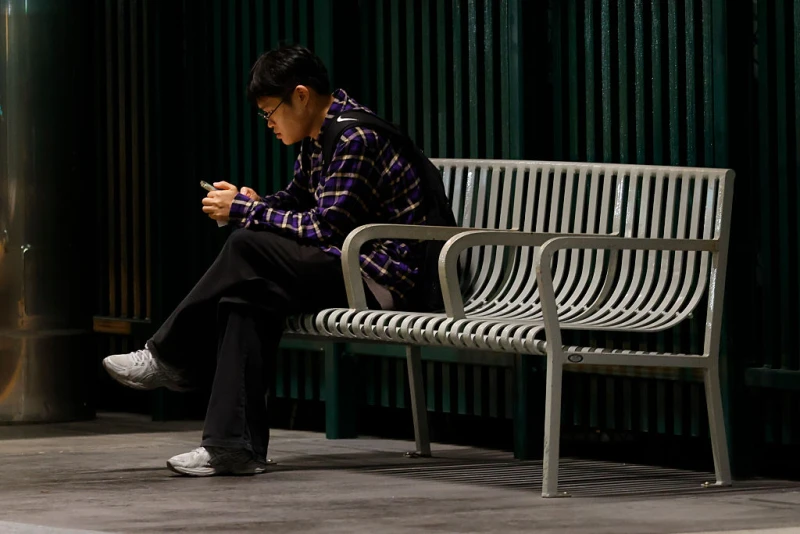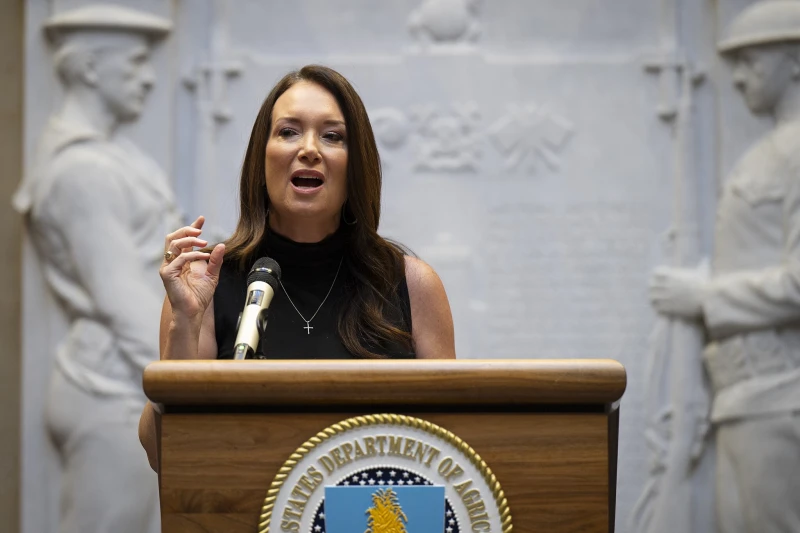

The 57.7-foot-long Canadarm2 robotic arm extends from a data grapple fixture on the International Space Station’s Harmony module in this July 23, 2025, image.
Read More

The 57.7-foot-long Canadarm2 robotic arm extends from a data grapple fixture on the International Space Station’s Harmony module in this July 23, 2025, image.
Read More

Washington, D.C. Newsroom, Oct 22, 2025 / 10:07 am (CNA).
Here’s a roundup of the latest Catholic education news in the United States:
Graduates of Catholic colleges and universities are outperforming other students in purpose and belonging and are reporting higher levels of mental health and financial stability, a report has found.
Students from Catholic institutions of higher education are 7% more likely to view their careers as meaningful, 14% more likely to report a strong sense of belonging, and 17% more likely to say they are satisfied with their mental health, according to this year’s Holistic Impact Report.
The annual report is published by the Center for Catholic Studies at St. Mary’s University (San Antonio) in partnership with YouGov.
The report also found that Catholic university graduates are more than 50% more likely to say their education encouraged them to engage in faith-based conversations and 12% more likely to say their courses promoted dialogue across differing perspectives.
“Higher education has been disrupted by political battles and financial pressures,” stated Jason King, the Beirne director and chair of the Center for Catholic Studies at St. Mary’s University.
But “Catholic higher education does not appear to be caught in those tides,” he said.
“With two years of data, we can see that it continues to form graduates for meaningful lives, community engagement, and ethical decision-making. And, because of this focus, it also supports graduates’ mental, financial, and social well-being.”
A Catholic school in California is leading an initiative to “raise” 1 million prayers by All Saints’ Day.
“This special initiative began on the eve of the canonizations of St. Carlo Acutis and St. Pier Giorgio Frassati, two modern witnesses who remind us that holiness is possible for everyone, especially the young,” St. Joseph School explained in a Facebook post on Oct. 3.
“Inspired by their example, our students, families, and faculty have already prayed more than 150,000 prayers… and we’re just getting started!” the school said.
“During this month of the holy rosary,” the school continued, “we are dedicating ourselves to praying the rosary together each day as a school community. Families are also recording their prayers at home; rosaries, Masses, traditional devotions, and personal prayers spoken from the heart.”
Three schools — Epiphany Catholic School in South El Monte, St. Anthony School in San Gabriel, and Santa Clara Elementary School in Oxnard — have also joined the initiative, according to the school.
The Archdiocese of San Antonio says its Catholic schools will now officially accept tuition from the Texas education savings account (ESA) program.
“Catholic schools in the Archdiocese of San Antonio are strongly promoting and participating in the Texas Education Freedom Accounts (TEFA) program, which provides funds for tuition at Catholic schools,” the archdiocese said in a statement to local media.
Under the program, students at Catholic schools will be able to receive $10,000 to cover tuition costs that will be placed in a savings account, providing increased flexibility to parents.
Inga Cotton, the founder and executive director of the San Antonio-based School Discovery Network, told media: “Catholic schools are some of the most affordable private schools in our region.”
She added that for “so many of them, the annual tuition is already below what the ESA will cover. It makes it more affordable for families.”
“Across the archdiocese, schools are preparing to welcome many new families through the launch of this effort,” the archdiocese said.
The legislation “was the result of hard work from many people through the years, who have been consistently advocating to give parents a true choice in education for their children.”
The Diocese of Pittsburgh is encouraging residents to take advantage of the state’s tax policy, which grants major tax breaks to those who donate to Catholic schools.
“The Catholic Diocese of Pittsburgh is making it easier than ever for individuals and businesses to transform their Pennsylvania state tax dollars into tuition assistance for Catholic school students, at no additional cost to them,” the diocese said in a statement this month.
“When you participate, you’re transforming lives,” Pittsburgh Bishop Mark Eckman said. “Every dollar given through this program helps open doors to a Catholic education that forms hearts, minds, and futures. It’s one of the simplest and most powerful ways to make a lasting difference for our children and our Church.”
According to the diocese, the state’s Educational Improvement Tax Credit programs enable participants to receive a 90% state tax credit when they contribute to the diocese’s approved scholarship fund.
The diocese has launched an online resource that offers step-by-step instructions on how to participate.
Read More

Washington, D.C. Newsroom, Oct 21, 2025 / 07:00 am (CNA).
A controversial ad campaign posted in the New York City subway system has sparked criticism and vandalism over the past few weeks. The print ads are selling an AI companion necklace called “Friend” that promises to be “someone who listens, responds, and supports.”
The device first launched in 2024, retailing at $129. It is designed to listen to conversations, process the information, and send responses to the user’s phone via a connected app. While users can tap the disc’s button to prompt an immediate response, the product will also send unprompted texts. The device’s microphones don’t offer an off switch, so it is constantly listening and sending messages based on conversations it picks up.
CNA did not receive a response to a question from Friend.com about the success of its subway ad campaign and how many people are currently using the devices, but Sister Nancy Usselmann, FSP, director of the Daughters of St. Paul’s Pauline Media Studies who also studies AI, told CNA that “people are turning to AI for companionship because they find human relationships too complicated.”
But “without that complicatedness, we cannot grow to become the best that we can be. We remain stagnant or selfish, which is a miserable existence,” she said.
Avi Schiffmann, the 22-year-old who started Friend.com, was a Harvard student before leaving school to focus on a number of projects. At 18, he created a website that tracked early COVID-19 data from Chinese health department sources. In 2022, he built another website that matched Ukrainian refugees with hosts around the world to help them find places to stay. He then founded Friend and now serves as the company’s CEO.
Schiffmann and his company first turned heads when an eerie video announcing the new gadget was released in July 2024. The advertisement featured four different individuals interacting with their “friends.” One woman takes a hike with her pendant, while another watches a movie with hers. A man gets a text from his “friend” while playing video games with his human friends. He first appears to be sad and lonely around his friends, until his AI “friend” texts him, which appears to put him at ease.
The marketing video ends with a young man and woman spending time together as the woman discusses how she has only ever brought “her” to where they are hanging out, referencing her AI gadget.
“It’s so strange because it’s awkward to have an AI in between a human friendship,” Usselmann said about the video ad.
Hundreds took to the comments section of the YouTube video to respond — mostly negatively — to both the Friend.com ads and the technology. Commentators called out the company for capitalizing on loneliness and depression. One user even called the video “the most dystopian advertisement” he had ever seen, and others wrote the video felt like a “horror film.”
“While its creators might have good intentions to bring more people the joys of companionship, they are misguided in trying to achieve this through a digital simulacrum,” Father Michael Baggot, LC, professor of bioethics at the Pontifical Athenaeum Regina Apostolorum in Rome, told CNA.
The device “suffers from a misnomer, since authentic friendship involves an interpersonal relationship of mutual support,” said Baggot, who studies AI chatbots and works on the development of the Catholic AI platform Magisterium AI.
“The product risks both worsening the loneliness epidemic by isolating users from others and undermining genuine solitude by intruding on quiet moments with constant notifications and surveillance. Friend commodities connection and may exploit human emotional vulnerabilities for profit,” he said, adding: “It might encourage users to avoid the challenging task of building real relationships with people and encourage them to settle for the easily controllable substitute.”
Usselmann agreed. “Only by reaching out in genuine compassion and care can another person who feels lonely realize that they matter to someone else,” she said. “We need to get to know our neighbors and not remain so self-centered in our apartments, neighborhoods, communities, or places of work.”
In a post to social media platform X on Sept. 25, Schiffmann announced the launch of the subway ad campaign. The post has more than 25 million views and nearly 1,000 comments criticizing the pendant and campaign — and some commending them.
Dozens of the ads have since been torn up and written on. People have posted images to social media of the vandalized ads with messages about the surveillance dangers and the general threats of chatbots. One urged the company to “stop profiting off of loneliness,” while another had “AI is not your friend” written on it.
One person added to the definition of “friend,” writing it is also a “living being.” It also had the message: “Don’t use AI to cure your loneliness. Reach out into the world!”
Usselmann said the particular issue with the campaign and device is “the tech world assuming certain words and giving them different connotations.”
“A ‘friend’ is someone with whom you have a bond based on mutual affection,” she said. “A machine does not have real affection because it cannot love. It does not have a spiritual soul from which intellect, moral agency, and love stem.”
She continued: “And from a Christian understanding, a friend is someone who exhibits sacrificial love, who supports through the ups and downs of life, and who offers spiritual encouragement and forgiveness. An AI ‘friend’ can do none of those things.”
Read More

Washington, D.C. Newsroom, Oct 20, 2025 / 05:20 am (CNA).
The Trump administration’s recent decision to cease publishing an annual U.S. Department of Agriculture report on household food insecurity is being met with strong criticism by the Catholic Health Association of the United States, anti-hunger activists, and academics.
The last USDA food insecurity report, covering 2024 data, is set for release Oct. 22. On Sept. 20, the USDA, led by Secretary of Agriculture Brooke Rollins, who was appointed by President Donald Trump, announced the termination of future “Household Food Security Reports,” which were first published in 1995 during the administration of then-President Bill Clinton.
“These redundant, costly, politicized, and extraneous studies do nothing more than fearmonger,” the USDA said in a published statement.
The USDA questioned the legitimacy of the annual reports, saying food insecurity trends have remained virtually unchanged since 1995, “regardless of an over 87% increase in SNAP spending between 2019–2023.”
SNAP is an acronym for “Supplemental Nutrition Assistance Program,” which according to the USDA “provides food benefits to low-income families to enhance their grocery budget so they can afford the nutritious food essential to health and well-being.” SNAP was formerly known as the “Food Stamp Program.”
The Trump administration explained its decision for discontinuing the reports, saying: “For 30 years, this study — initially created by the Clinton administration as a means to support the increase of SNAP eligibility and benefit allotments — failed to present anything more than subjective, liberal fodder.”
“I don’t think collecting data about food insecurity across the country is ‘liberal fodder,’” said Lisa Smith, vice president of advocacy and public policy for the Catholic Health Association of the United States, which generally aligns with Church teaching but has clashed with the U.S. bishops in the past on health care issues, such as the Affordable Care Act. “When you don’t have the data, it makes it more difficult to know where the keys areas of need are.”
The end of the annual food security report “is going to impact the health of low-income communities,” Smith said. Smith’s concerns were echoed by Colleen Heflin, a professor of public administration and international affairs at Syracuse University and co-author of “Food for Thought: Understanding Older Adult Food Insecurity,” a book published last month along with Madonna Harrington Meyer, a sociology professor at Syracuse.
“Without national data from the Current Population Survey on food insecurity, it will no longer be possible to track year-to-year variation in food insecurity due to changing economic and policy conditions,” Heflin said. “This lack of data will make it harder for Catholic charities and other community-based organizations to effectively address food insecurity without a consistent and comprehensive understanding of how food insecurity is changing for different demographic and geographic communities.”
Like Smith, Heflin dismissed the Trump administration’s claim that the reports were little more than liberal, redundant fearmongering.
“Food insecurity data collection has been a bipartisan issue since the Reagan administration,” since the 1980s, Heflin said. Referring to the Trump administration’s plan to end the annual report, Heflin said she found “both the decision and the justification provided quite shocking and without merit.”
James Ziliak, a professor of microeconomics and founding director of the Center for Poverty Research at the University of Kentucky, told CNA that eliminating the USDA household food security reports could reduce public and policy awareness of hunger needs and hinder private-sector responses, such as those by Catholic health and social service organizations.
“This report was one of the most widely watched barometers of economic well-being among low- and moderate-income households in the U.S. and provided key information for policymakers, charitable organizations, and researchers,” Ziliak said in an email.
Like Smith and Heflin, Ziliak said he did not accept the Trump administration’s explanation for ending publication of the annual report.
“This is absolutely not justified, and the timing is especially harmful to public policy as the economy slows down and major cuts are being implemented in the largest federal food assistance program,” he said, referring to SNAP.
Read More

Westerlund 1 is the biggest and closest “super” star cluster to Earth. Data from Chandra and other telescopes are helping astronomers delve deeper into this galactic factory where stars are vigorously being produced. Observations from Chandra have uncovered thousands of individual stars pumping out X-ray emission into the cluster.
Read More

This view of tracks trailing NASA’s Curiosity rover was captured July 26, 2025, as the rover simultaneously relayed data to a Mars orbiter.
Read More

The Andromeda galaxy, also known as Messier 31 (M31), is the closest spiral galaxy to the Milky Way at a distance of about 2.5 million light-years. This new composite image contains data of M31 taken by some of the world’s most powerful telescopes in different kinds of light. This image is released in tribute to the groundbreaking legacy of Dr. Vera Rubin, whose observations transformed our understanding of the universe.
Read More

This new image showcases the dazzling young star cluster NGC 346. Although both the James Webb Space Telescope and the Hubble Space Telescope have released images of NGC 346 previously, this image includes new data and is the first to combine Hubble observations made at infrared, optical, and ultraviolet wavelengths into an intricately detailed view of this vibrant star-forming factory.
Read More

In about 5 billion years, our Sun will run out of fuel and expand, possibly engulfing Earth. These end stages of a star’s life can be utterly beautiful – as is the case with this planetary nebula called the Helix Nebula. Astronomers study these objects by looking at all kinds of light. This images show X-rays from NASA’s Chandra X-ray Observatory (magenta), optical light data from NASA’s Hubble Space Telescope (orange, light blue), infrared data from the European Southern Observatory VISTA telescope (gold, dark blue), and ultraviolet data from GALEX (purple) of the Helix Nebula.
Read More

This updated version of “the Pale Blue Dot,” made for the photo’s 30th anniversary in 2020, uses modern image-processing software and techniques to revisit the well-known Voyager view while attempting to respect the original data and intent of those who planned the images.
Read More

This composite image contains the deepest X-ray image ever made of the spectacular star forming region called 30 Doradus. By combining X-ray data from NASA’s Chandra X-ray Observatory (blue and green) with optical data from NASA’s Hubble Space Telescope (yellow) and radio data from the Atacama Large Millimeter/submillimeter Array (orange), this stellar arrangement comes alive.
Read More

LEDA 1313424, aptly nicknamed the Bullseye, is two and a half times the size of our Milky Way and has nine rings — six more than any other known galaxy. High-resolution imagery from NASA’s Hubble Space Telescope confirmed eight rings, and data from the W. M. Keck Observatory in Hawaii confirmed a ninth. Hubble and Keck also confirmed which galaxy dove through the Bullseye, creating these rings: the blue dwarf galaxy that sits to its immediate center-left.
Read More

NGC 602 is a star cluster that lies on the outskirts of the Small Magellanic Cloud, one of the closest galaxies to the Milky Way. This image combines X-rays from NASA’s Chandra X-ray Observatory and infrared data from NASA’s James Webb Space Telescope (JWST).
Read More

NASA astronauts Loral O’Hara, left, and Jasmin Moghbeli, right, are seen during a tour of the Earth Information Center, Wednesday, Dec. 4, 2024, at NASA Headquarters in Washington. O’Hara and Moghbeli spent six months in space as part of Expedition 70 aboard the International Space Station.
Read More